A comprehensive macaron troubleshooting guide with photos, possible causes and how to avoid the most common macaron issues!
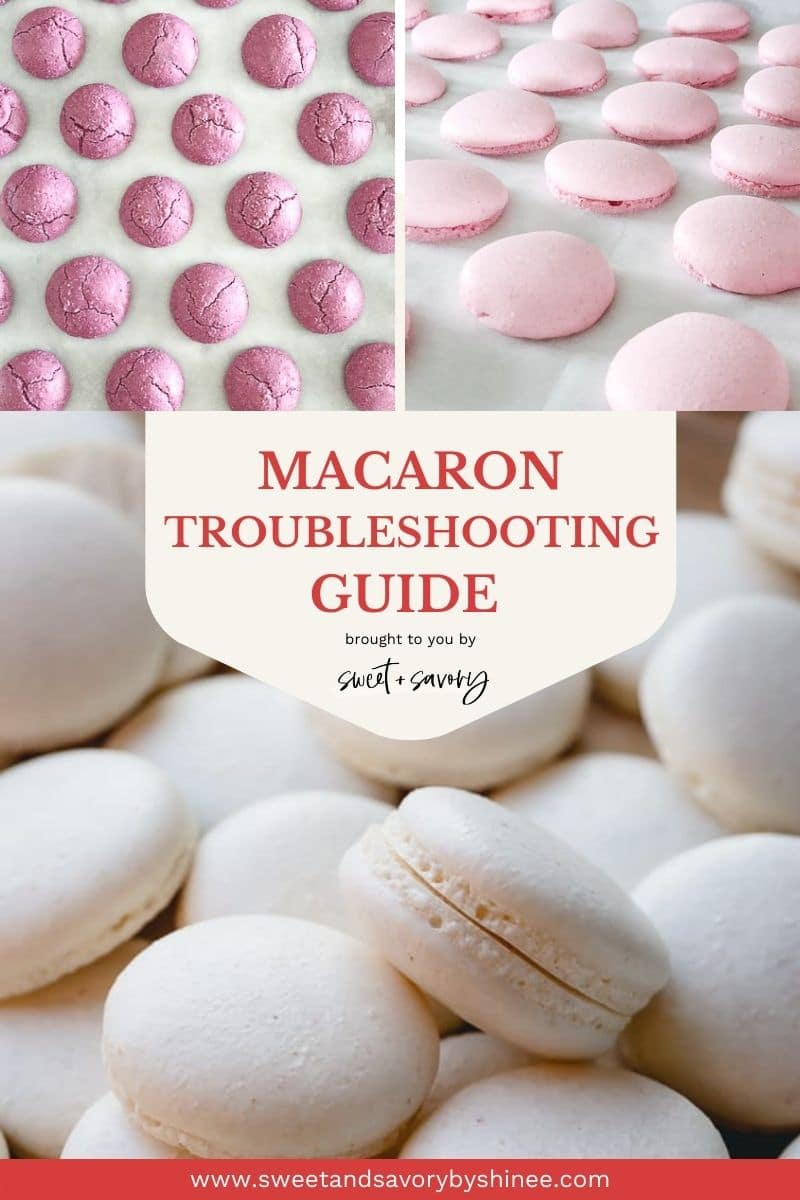
Table of Contents
Since 2012, I’ve made thousands of macarons in my home kitchen with many trials and errors, as well as picture-perfect macarons! And yes, I’ve had pretty much every problem imaginable!!
In the process, I’ve gained lots of tips and tricks to solve those frustrating issues and, most importantly, how to avoid them in the first place.
Remember, sometimes, macarons fail for no apparent reason and leave us scratching our heads.
But I encourage you to never give up on macarons. The joy of watching your macarons grow those ruffled feet and pulling out perfectly round macarons with shiny smooth tops is simply priceless.
I swear, every single time, when I see my macarons through the oven door puffing up and baking perfectly, I can’t help but do a little happy dance in my kitchen! Pure joy, I’m telling ya!
What’s a perfect macaron?
Perfect macaron is very subjective. To me, a perfect macaron has the following characteristics:
- Smooth shells
- Ruffles feet
- Full inside
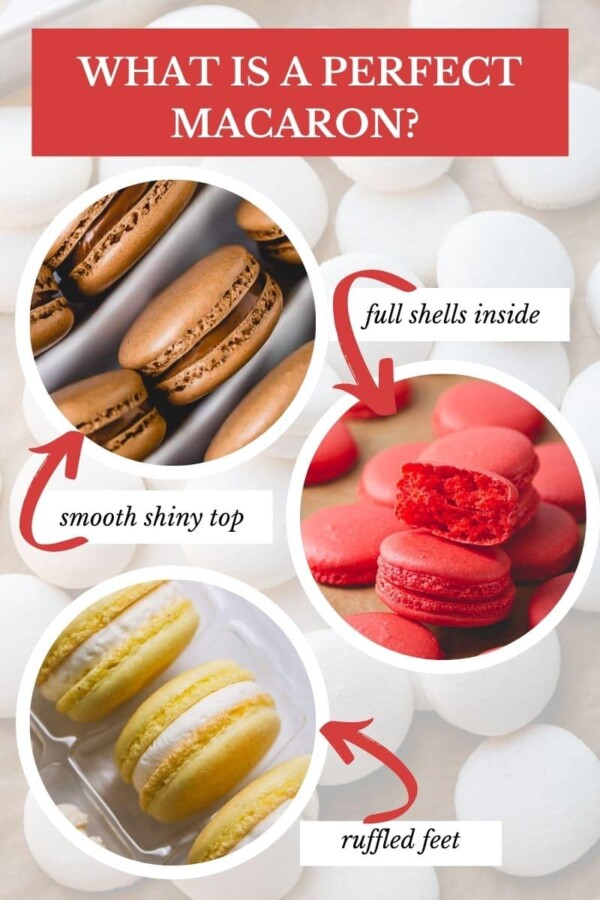
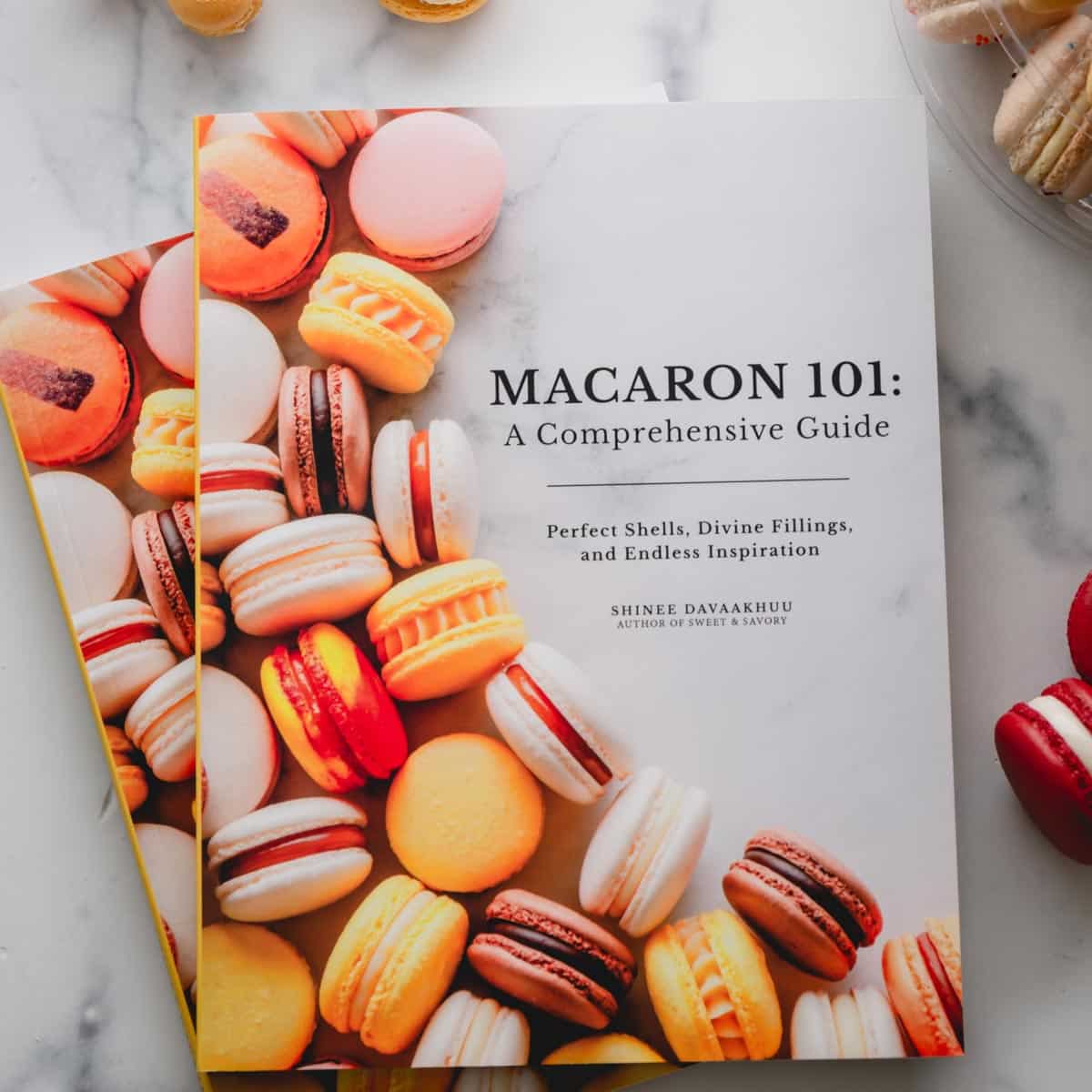
Macaron 101: A Comprehensive Guide
Master the art of French macarons and create your signature flavors!
Macaron Troubleshooting Video
Visual Macaron Troubleshooting Guide
Ok, let’s discuss each of the most common macaron issues, their causes and how to fix or prevent them!
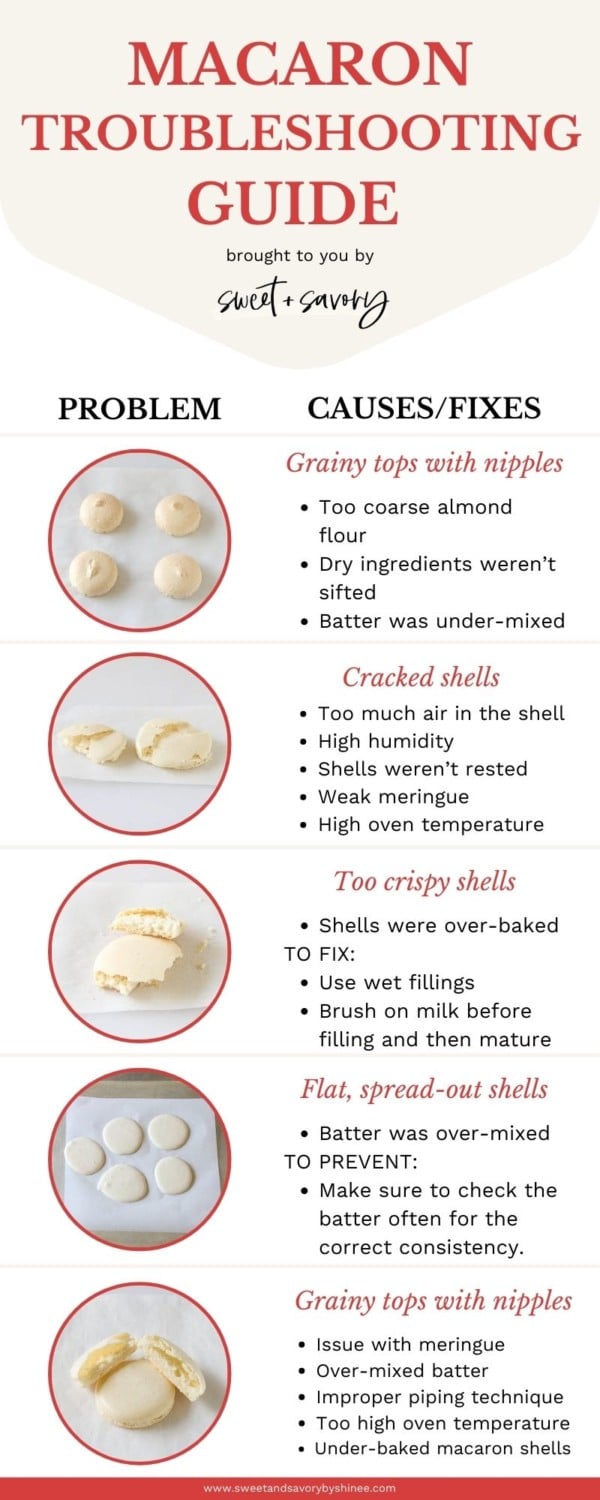
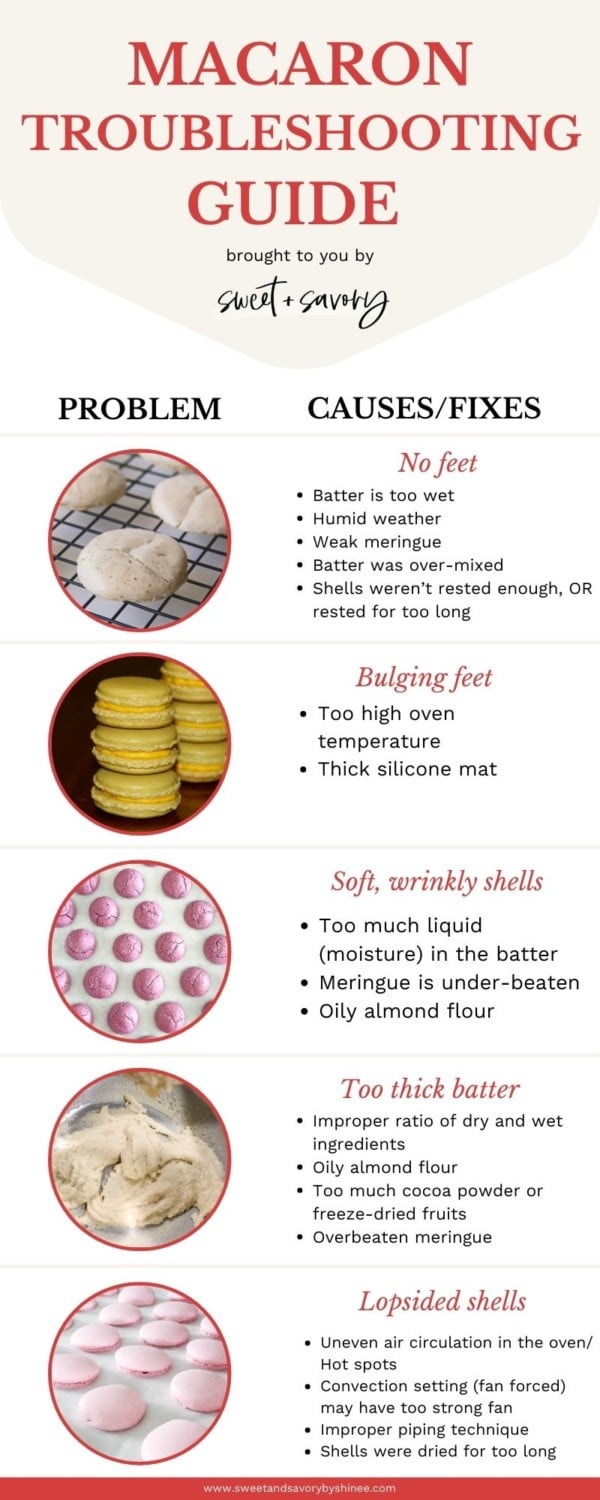
Pin this now to find it later
Pin ItUneven, grainy macarons with nipples
Possible causes:
- Too coarse almond flour
- Dry ingredients weren’t sifted
- Batter was under-mixed
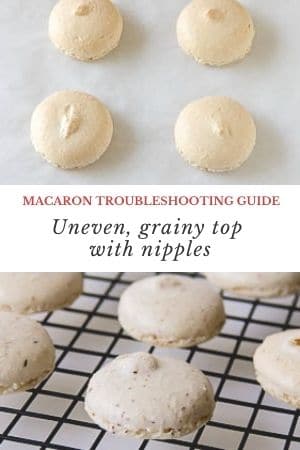
how to fix grainy shells with nipples:
- Make sure to use fine ground almond flour.
- Don’t skip sifting the dry ingredients! Toss large almond pieces left in the sifter. You shouldn’t have more than 1/2 tablespoon of almond bits.
- Under-mixed batter also causes grainy shells with nipples. When mixed right, the nipples should melt back into the batter after tapping the piped shells on the counter.
don’t do this!
Never use wet fingers to push the nipples down. Instead, use a toothpick to encourage the batter even out.
Cracked shells
Possible causes:
- Too much air in the shell
- High humidity
- Shells weren’t rested
- Weak meringue
- High oven temperature, or hot spots in the oven
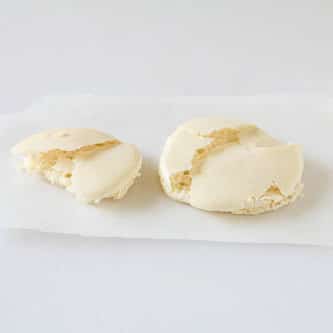
HOW TO FIX cracked macarons:
- Be sure to tap the baking sheet right after piping macaron shells. And use a toothpick to pop large air pockets visible on the surface.
- When it’s too humid, the shells don’t develop good skin, which leads to the next point.
- When the shells haven’t rested long enough to develop skin on top, steam releases from anywhere cause macarons to crack on top.
- Take your time to make nice and sturdy meringue, especially when you’re making French meringue. Watch my video on French Meringue 101 to learn all the tips to make the most stable French meringue.
- Too hot oven can also cause cracks in macaron shells. Make sure to get an oven thermometer to double check the temperature inside the oven without relying on what oven says.
Erupted shells
Possible cause:
- Touched the shells with wet finger to push down a pointy nipple
How to prevent erupted volcano macarons:
Never touch your unbaked macaron shells with wet fingers to push down pointy end. Instead tap the baking sheet well. And if the pointy end doesn’t melt into the batter, you can either baking them as is, or scrape the batter back into a bowl and mix for a little more until the batter is at correct consistency.
Too crispy interior
Possible cause:
- Shells were over-baked
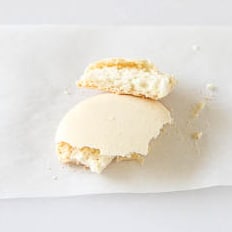
How to fix too crispy shells:
If you over-baked your macaron shells and now they’re super crispy throughout, don’t fret! 2 easy fixes:
- Use wet fillings, like jams, caramel sauce, or lemon curd in the center.
- Simply brush on milk on the bottom of the shells before piping a filling of choice.
don’t miss this important step
Mature the filled macarons for 24 hours. The shells will absorb the moisture from filling and macarons should soften nicely.
Flat shells, spread out too much
Possible cause:
- Batter was over-mixed
Over-mixed batter is too loose and the shells don’t hold its shape well, instead it spreads out too much.

How to prevent flat, spread out macarons:
Once macaron batter is over-mixed and it’s too runny, there’s no way to salvage it. So it’s important to prevent this from happening.
Make sure to check the batter often for the correct consistency. It should slowly run off the spatula into a ribbon, and the edges should melt back into the batter within about 10 seconds.
Hollow shells
Possible cause:
- Issue with meringue
- Over-mixed batter
- Improper piping technique
- Too high oven temperature
- Under-baked macaron shells
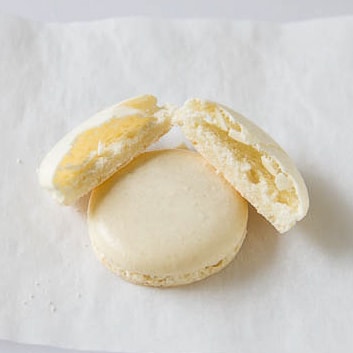
How to fix hollow macaron shells:
Hollow macarons are so common, and I personally battled with this issue for a long time. Now, I consistently get full, meaty macarons straight from the oven.
Since it’s a complex issue, I dedicated a separate post on how to fix hollow macarons.
No feet
Potential causes:
- Batter is too wet
- Humid weather
- Weak meringue
- Batter was over-mixed
- Shells weren’t rested before baking
- Shells were rested for too long, weakening the meringue structure
- Too low oven temperature
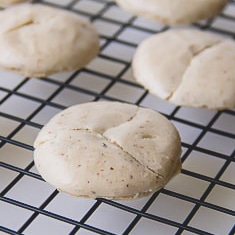
How to prevent no feet macarons:
- When the batter is too wet, macarons don’t develop those ruffled feet. The most common causes for wet batter: excess liquids, like extracts, lemon/lime juice, liquid food coloring, too much gel food coloring, etc.
- In some cases, especially in humid climates, aging egg whites might be beneficial. During aging, egg whites loose some of its moisture.
- When the meringue isn’t whipped to stiff peaks, it doesn’t have strong enough structure to lift macarons. Watch my French Meringue 101 video for visual cues for proper meringue.
- When macaron batter is over-mixed, there’s not much air bubbles left to give the shells lift during baking. Therefore, they come out flat without feet.
- Also, if macarons weren’t rested to form a skin before baking, it could cause no feet macarons. And if the shells were rested for too long, it can also negatively affect the batter, because meringue loses its stability when sat for too long. Keep checking the shells every 15 minutes and put them in the oven as soon as they don’t stick to your fingers.
- If the oven is not hot enough, macarons won’t rise as air bubbles in the meringue need heat to expand to lift the shells, creating that pretty feet at the base.
check the accuracy of your oven
Make sure to get an oven thermometer to double check the temperature inside the oven without relying on what oven says.
Bulging feet
Potential causes:
- Too high oven temperature
- Silicone mat
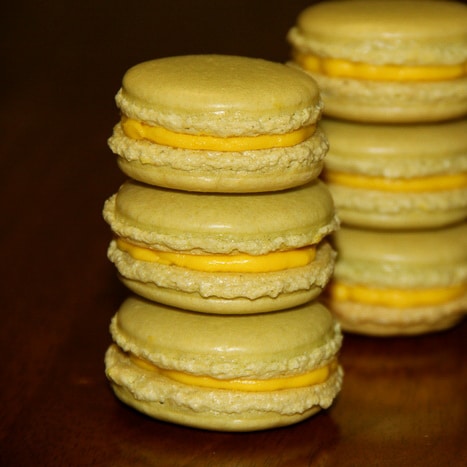
how to prevent bulging feet:
Some may find it ugly when the ruffled feet extends out of the macaron shells. I’m not a huge fan, but it’s not the worst!
- This happens when the oven is a bit too hot, causing the macarons to rise too high and then collapse slightly, making the feet bulge out.
- And another reason is silicone mat might be the culprit. I certainly happens to me with thick silicone mats, but I know some people have gorgeous macarons with silicone mats.
Soft, wrinkly shells
Possible causes:
- Too much liquid (moisture) in the batter
- Meringue is under-beaten
- Oily almond flour
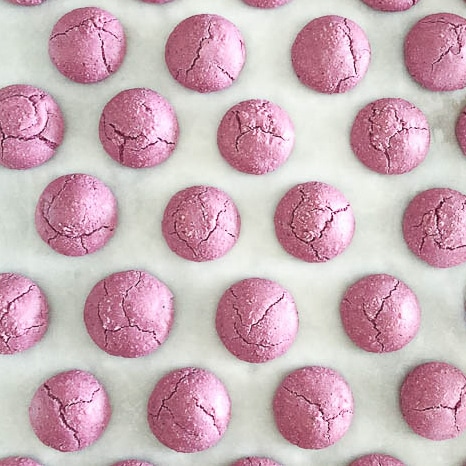
How to prevent soft, wrinkly shells:
Excess moisture and/or fat is the #1 cause for soft, wrinkly shells. And there’re number of culprits for excess moisture/fat in the batter:
- Adding liquid extracts, juices or liquid food coloring
- Adding cocoa powder, freeze-dried fruits, etc.
- Under-mixed meringue also contains too much moisture
- Oily almond flour, or almond flour that has been opened for too long
Cocoa powder contains fat which could potentially cause soft, brownie-like macaron shells. And freeze-dried fruits absorb moisture from the air fast and could cause soft, wrinkly shells as well.
how to store almond flour
Store opened almond flour in an airtight container in a cool place. You can also store in the freezer for long-term storage.
Too Thick batter
Typically, when you add dry ingredients into meringue, it starts out pretty thick and that’s totally normal. As you fold the batter, it thins out and gets runnier.
In rare occasions, the batter never loosens and it stays thick.
Possible causes:
- Improper ratio of dry and wet ingredients
- Oily almond flour
- Too much cocoa powder or freeze-dried fruits
- Overbeaten meringue
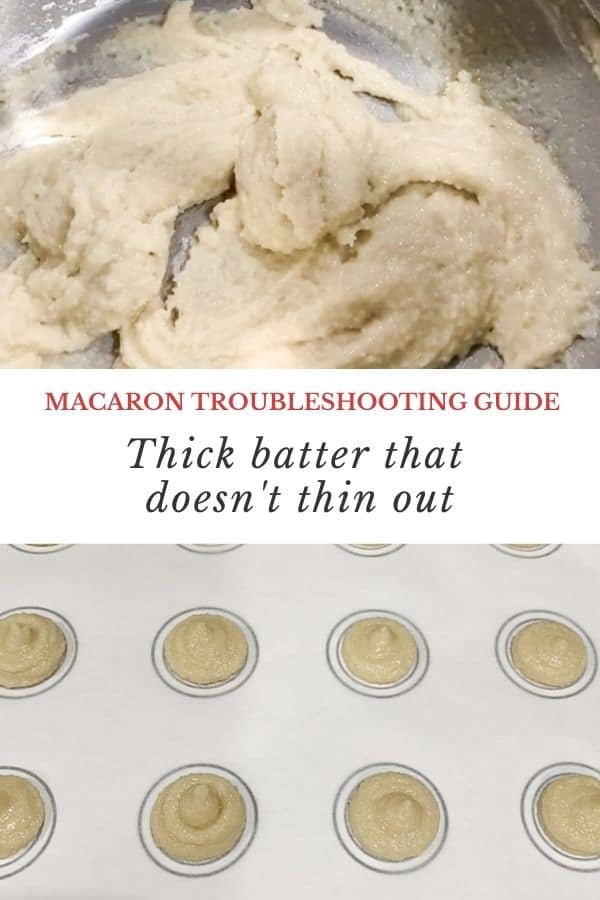
how to fix and prevent thick batter issue:
- Be sure to weigh the ingredients carefully. I strongly recommend weighing all the ingredients, including egg whites, with a kitchen scale.
- Oily almond flour could cause thick batter. Make sure to use fresh almond flour and avoid processing it in a food processor.
- Too much cocoa powder or freeze-dried fruits can throw the ratio of dry and wet ingredients.
- When meringue is over-beaten, it gets dry, throwing off the ratio as well.
Blotchy shells
I don’t have a photo of this issue, but basically it looks like greasy stains on the shells.
Possible causes:
- Oily almond flour
- Batter sat out for too long before piping
how to prevent blotchy macarons:
- Use fresh almond flour that’s not oily. To test, squeeze some almond flour in your hand and see if it holds its shape. If it holds its shape like wet sand, then it’s too oily.
- Make sure to pipe the shells right away, especially with French meringue batter.
Lopsided shells
Possible causes:
- Uneven air circulation in the oven/ Hot spots
- Convection setting (fan forced) may have too strong fan
- Improper piping technique
- Shells were dried for too long
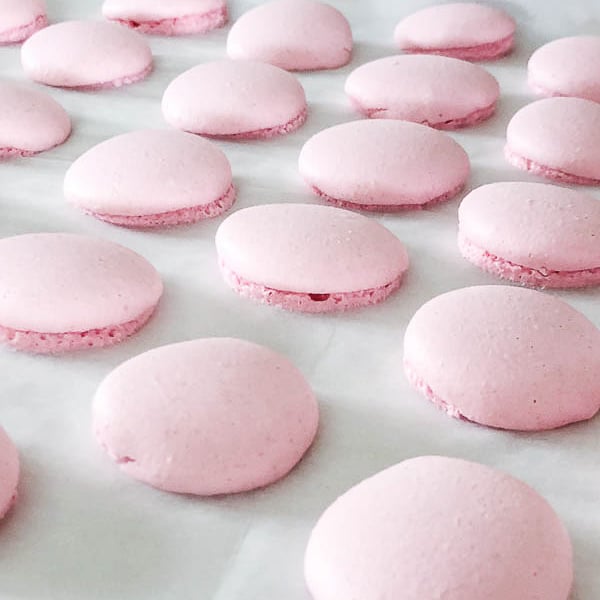
how to prevent lopsided macarons:
Main culprit for lopsided shells is poor air circulation. This could be due to uneven heat distribution and hot spots in the oven, convection settings with too strong fan. Here’re a few things you can do in this case:
- Flip the baking sheet upside down before piping macarons, so that there’s no edges around the sheet to block any heat circulation.
- Bake macarons one sheet at a time.
- Turn the baking sheet around half way through baking.
- If possible, bake on conventional setting, heat coming from top and bottom.
The next reason for lopsided macarons is improper piping technique. Pay close attention to following:
- Hold the piping bag with macaron batter straight at 90° and squeeze the batter from the top to one spot until the desired size reaches. Watch my macaron video for better illustration.
- Pipe the shells at least half an inch apart to give the shells enough room for air circulation.
And lastly, don’t dry your macarons for too long. Too thick skin may cause lopsided macarons.
Concaved (Inverted) shells or Stuck To Parchment
Possible causes:
- Low oven temp/ low heat from bottom
- Under-baked shells
- Not cooling the macarons before removing from parchment paper
How to prevent concaved, or stuck macarons:
- Make sure your oven is hot enough. Most of the time, ovens need good 30-45 minutes to preheat properly. Even if it beeps when it’s preheated, I highly recommend double checking with an oven thermometer.
- Be sure to check the macarons for doneness before taking them out. To test for doneness, gently touch the top of one macaron with your index finger and try wiggle it. If it wobbles side to side, they’re not ready. keep baking for another minute or so. The cooked shells should wiggle ever so slightly and firm to touch. When in doubt, cook a bit longer. In my opinion, it’s better to over-bake them than under-bake them.
- Make sure to cool the macarons on the baking sheet for at least 10 minutes before removing from parchment paper/silicone mat.

Macaron 101: A Comprehensive Guide
Master the art of French macarons and create your signature flavors!

Whew, are you still with me? Thank you!!! I hope this macaron troubleshooting guide answers your questions and helps you to perfect your macaron skills.
And if there is anything I haven’t covered, please leave me a comment below. I’d like us, macaron-lovers, connect and discuss various problems we face baking macarons. Let’s get the discussion started.



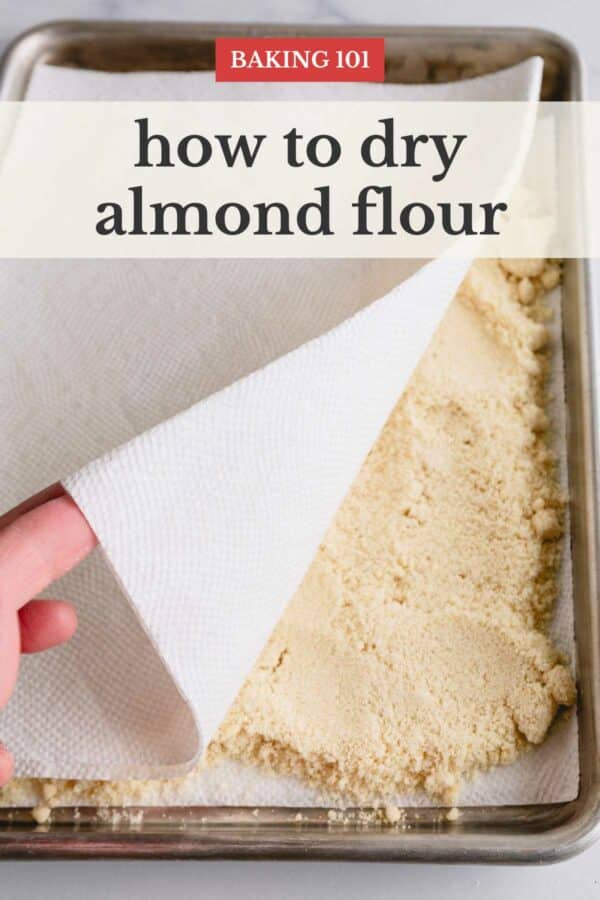


How do you get pastel colours? If I use light colours they never look like I want them once cooked.
Hi, Della. I think it depends on the brand of food coloring. I use Americolor gel food coloring, and I never have that issue. What brand do you use?
Thanks for all the great tips. No matter what they look like, the taste is glorious!
Agreed! Glad you found the tips helpful, Diane!
Hii thank u for all the tips they are a savior!! Also my macarons turn soggy the minute I fill them and then crack.. what should I do to prevent this happening again?
Thanks in advance
Hi, Yuvi. I’m super confused by this. So the shells are nice and crisp before filling? What kinds of filling are you using?
Hii yes they were crispy and well done.. I had some chocolate ganache piped in but they just got soggy and cracked. Pls suggest what I can do to prevent this
Thanks in advance
I’m honestly no idea why perfectly crips macarons crack and turn soft immediately after filling. If you have an image please e-mail it to me, or share it via DM on Instagram.
So a bit of an odd question but about how thick is a finished macaron once the icing has been added and both cookies are together? I’m working on a project for school to design a package for a set of macarons and I can’t find final height dimensions anywhere which is something I really need to know. Thanks!
Hi, there! I’m sure they’re all depends on the baker. But my filled macarons are typically 3/4-1-inch thick.I have a clam shell macaron box and each macaron slot is 1-inch. Hope that helps.
It does! Thanks!
I didn’t have a scale to measure ingredients and also, I converted the grams to cups. That could be part of the problem.
So, macarons are finicky cookies and require precise amount of ingredients, that’s why I don’t recommend volume measurement. If you folded your batter for a long time and it just didn’t get looser, then I’d suspect your ingredients ratio was off. Hope this helps.
Mine didn’t have feet. And when I banged the pan, the tips wouldn’t disappear. Makes me think I over beat the meringue. Is that correct? They didn’t stick to the parchment, which made me happy. And they taste great. They are also a little hollow and didn’t spread at all.
Hi, Teresa. Thank you for reaching out. Which macaron recipe did you try? It sounds like the batter was under-mixed. If you haven’t watched my macaron video, I recommend watching it. You can see the correct consistency of the batter.
These little cookies are MADDENING!!! I made a batch this morning, came out perfect. Tried another later, disaster. Re-did them, disaster again. (The first batch was traditional vanilla, second and third were key lime). Some were cracked, and kind of peaked like a volcano. Others were flat and uneven, with lopsided feet. I don’t know what I did wrong, I made them exactly like the first batch. Trouble shooting guides say they are cracking because of undermixing, and flat because of overmixing, so I’m at a loss as to how I could have both situations in the same batch. UGH!!!
Hi there! Oh how I understand the frustration!!! These macaron can be so finicky!! What did you add for key lime flavoring? It’s totally possible the additional ingredient(s) are the culprit.
Hi! I used a pinch of key lime zest and a 1/4 tsp of the key lime juice (from fresh squeezed). I think I may have solved parts of the issue. I switched to a different recipe (still baffled by the HUGE difference in ingredient ratios between recipes!) and beat my meringue to a stiffer consistency, then pressed more when folding “through” on the macronage. I think I had too much air in my batter. The new recipe created some good shells, but a lot of them were lopsided, which I attribute to my parchment paper not being flat and possibly oven temp too low, as they were hollow at the very top. I was baking the first recipe at 285 for 16min. I’m going to experiment with 295-300 for less time, see if that helps with the hollowing.
So what I did was I had most of my cookies on a silicone mat and a couple of them on parchment paper. I accidentally made the ones on the silicone mat too big, and they didn’t get any feet. They were also super moist and part of them stuck to the silicone mat, even after I baked them for a few more minutes. They did have a smooth top though. As for the ones on parchment paper, which were smaller and more even, they also had a smooth top. They didn’t stick. I think I didn’t fold the batter enough, because my batter wasn’t as liquidy as they look in the videos. But I’m not sure… Can someone help me out? Any tips for next time?
wait nevermind none of them were smooth haha
What do you mean? Did they get wrinkly?
First of all, thanks so much for replying! I really appreciate it. No, I did not bake them one at a time. I put the silicone mat on the upper rack and the parchment paper on the lower rack. Thanks for the advice, I’ll try that next time. No the macarons didnt get wrinkly, they cracked.
Ok, yeah, I suspected you baked the trays at the same time. So your top tray with silicone mat didn’t get enough heat from the bottom, because the tray on the bottom block the heat source. And silicone mat do need more heat to cook the macarons because they’re insulate the tray. I suggest baking the trays one at a time.
Hi, Kim. Did you bake the tray one at a time? It sounds like your macarons on silicone mat were under-baked. I’d either increase the temp slightly and/or bake longer.
I love your blog, this tips are great!
So happy to hear my blog is helpful to you!! Thank you for your feedback, Felisha!
So in order for me to get the perfect macaron batter, Do I just fold the macaron batter 40 – 60 times? I saw this info online and i am not sure if it is correct…
Hi, Ryan. Unfortunately, it’s not that simple. 🙂 Counting the folds is just to guide you. When you’re working on your macaron technique and when you’re not quite sure what is the perfect batter consistency, it’s helpful to count the folds. Typically, after about 50-60 folds, the batter is pretty close to being perfect. After that point you want to work really carefully, checking the batter consistency every 2-3 folds. Hope this makes sense. Let me know if you have any questions.